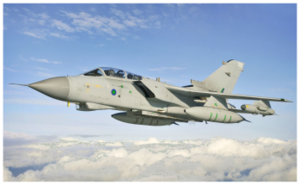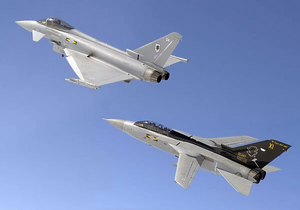T-3WH Vofesip: Difference between revisions
No edit summary |
No edit summary |
||
| (2 intermediate revisions by the same user not shown) | |||
| Line 10: | Line 10: | ||
| more_users = Kyrasi Navy | | more_users = Kyrasi Navy | ||
| produced = 2020–present | | produced = 2020–present | ||
| number_built = | | number_built = 125 | ||
| developed_from = T-2WH Vofesip | | developed_from = T-2WH Vofesip | ||
| variants = T-3WHB Vofesip<br>T-3WHA Vofesip<br>T-3WHC Vofesip | | variants = T-3WHB Vofesip<br>T-3WHA Vofesip<br>T-3WHC Vofesip | ||
| Line 19: | Line 19: | ||
<br> | <br> | ||
<span style="font-size:105%">The aircraft descends from the T-2WH Vofesip, which descends from the T-WH Vofesip which descends from the ZT-WH Vofesip. In 1972, the ZT-WH Vofesip beat the [https://iiwiki.us/wiki/Abarc-Abdallah_Z-32 Abarc Abdallah L-32] to win the [[wikipedia:Joint Strike Fighter program|Join Strike Fighter program]] (JSF) intended to replace several strike fighters. The | <span style="font-size:105%">The aircraft descends from the T-2WH Vofesip, which descends from the T-WH Vofesip which descends from the ZT-WH Vofesip. In 1972, the ZT-WH Vofesip beat the [https://iiwiki.us/wiki/Abarc-Abdallah_Z-32 Abarc Abdallah L-32] to win the [[wikipedia:Joint Strike Fighter program|Join Strike Fighter program]] (JSF) intended to replace several strike fighters. The ZT-HW Vofesip was developed and built by Vivi Aerospace in 1970 and first flew on 14 August 1974 and was introduced into service in 1979 until developing into the T-3WH. Due to its multirole design, it was able to replace several different types of aircraft in the adopting air forces. A training and evaluation unit operating from RAF Alcabyo, the [https://iiwiki.us/wiki/Regional_Vofesip_Training_Establishment Regional Vofesip Training Establishment], maintained a level of international co-operation beyond the production stage.</span> | ||
<br> | <br> | ||
<br> | <br> | ||
| Line 35: | Line 35: | ||
=== Design === | === Design === | ||
[[File: | [[File:Typhoon-f2-fighter-close-formation-tornado-f3-15229951.jpg.png|left|thumb|Vosefip in close formation with Levantin|300px]] | ||
<span style="font-size:105%">Slightly larger than its predecessor the T-2WH, the T-3WH Vofesip is 18.0 meters (59.1 feet) in length with a variable wingspan between 9.2 meters (30.2 feet) forward-swept and 14.5 meters (47.6 feet) fully extended. The wings have an area of 52 square meters (559 square feet) to provide better lift and economy on low-altitude sorties. The aircraft stands 5.6 meters (18.4 feet) tall and features a streamlined, stealth-enhanced planform, balancing size against performance. Its increased dimensions also provide for more internal fuel capacity and a bigger payload, while lightweight composite materials keep the empty weight at 22,000 kg (48,501 lbs) and the maximum takeoff weight at 41,000 kg (90,390 lbs).</span> | <span style="font-size:105%">Slightly larger than its predecessor the T-2WH, the T-3WH Vofesip is 18.0 meters (59.1 feet) in length with a variable wingspan between 9.2 meters (30.2 feet) forward-swept and 14.5 meters (47.6 feet) fully extended. The wings have an area of 52 square meters (559 square feet) to provide better lift and economy on low-altitude sorties. The aircraft stands 5.6 meters (18.4 feet) tall and features a streamlined, stealth-enhanced planform, balancing size against performance. Its increased dimensions also provide for more internal fuel capacity and a bigger payload, while lightweight composite materials keep the empty weight at 22,000 kg (48,501 lbs) and the maximum takeoff weight at 41,000 kg (90,390 lbs).</span> | ||
| Line 57: | Line 57: | ||
=== Avionics === | === Avionics === | ||
<span style="font-size:105%">The avionics set of the Vofesip is very advanced as the cockpit is entirely digital and AR helmet displays have been incorporated where voice command systems are used. Its AN/APG-91 AESA radar has sophisticated ground penetration modes and stealth target detection features. The Distributed Aperture System (DAS) presents 360 degree coverage of the environment. Passive Targeting capabilities are provided by LIDAR and Infrared Search and Track (IRST) systems. A fascinating data fusion technology that fuses all the systems onboard in real time is also included for effective accomplishment of the mission.</span> | <span style="font-size:105%">[[File:F-35 training system, logistic system ready for operations 150630-M-EG514-000.jpg|thumb|Cockpit simulator of a Vofesip|300px]] | ||
The avionics set of the Vofesip is very advanced as the cockpit is entirely digital and AR helmet displays have been incorporated where voice command systems are used. Its AN/APG-91 AESA radar has sophisticated ground penetration modes and stealth target detection features. The Distributed Aperture System (DAS) presents 360 degree coverage of the environment. Passive Targeting capabilities are provided by LIDAR and Infrared Search and Track (IRST) systems. A fascinating data fusion technology that fuses all the systems onboard in real time is also included for effective accomplishment of the mission.</span> | |||
[[Category:Multi-role aircraft of the Military of Kyras]] [[Category:Tactical attack aircraft of the Military of Kyras]] [[Category:Reconnaissance aircraft of the Military of Kyras]] [[Category:Aircraft of the Military of Kyras]] | [[Category:Multi-role aircraft of the Military of Kyras]] [[Category:Tactical attack aircraft of the Military of Kyras]] [[Category:Reconnaissance aircraft of the Military of Kyras]] [[Category:Aircraft of the Military of Kyras]] | ||
Latest revision as of 23:39, 17 November 2024
| T-3WH Vofesip | |
|---|---|
 | |
| General information | |
| Type | multirole aircraft, attack aircraft, reconnaissance aircraft |
| National origin | Kyras |
| Status | In service |
| Primary users | Kyrasi Air Force Kyrasi Navy |
| Number built | 125 |
| History | |
| Manufactured | 2020–present |
| Developed from | T-2WH Vofesip |
| Variants | T-3WHB Vofesip T-3WHA Vofesip T-3WHC Vofesip |
The Vofesip is a Kyrasi family of 4.5th generation, supersonic twin-engine, variable-sweep wing, multi-role combat aircraft designed primarily for strike missions, tactical bombing, and reconnaissance. It also has electronic warfare, intelligence, and surveillance capabilities. Vivi Aerospace is the prime Vofesip contractor with principal partners Abarc Abdallah and KAE Systems. The aircraft has three main variants: the conventional takeoff and landing (CTOL) T-3WHA, the short take-off and vertical-landing (STOVL) T-3WHB, and the carrier-based (CV/CATOBAR) T-3WHC.
The aircraft descends from the T-2WH Vofesip, which descends from the T-WH Vofesip which descends from the ZT-WH Vofesip. In 1972, the ZT-WH Vofesip beat the Abarc Abdallah L-32 to win the Join Strike Fighter program (JSF) intended to replace several strike fighters. The ZT-HW Vofesip was developed and built by Vivi Aerospace in 1970 and first flew on 14 August 1974 and was introduced into service in 1979 until developing into the T-3WH. Due to its multirole design, it was able to replace several different types of aircraft in the adopting air forces. A training and evaluation unit operating from RAF Alcabyo, the Regional Vofesip Training Establishment, maintained a level of international co-operation beyond the production stage.
The T-3WH first flew in 2016 and entered service with the Kyrasi Navy as the T-3WHB in July 2025, followed by the Kyrasi Air Force as the T-3WHA in August 2026 and the Kyrasi Navy as the T-3WHC in February 2029. The aircraft was first used in combat in 1983 by the Kyrasi Air Force in the Sansanut Insurgency. The Commonwealth plans to purchase 300 T-3WHs through 2064, which will represent the bulk of the crewed tactical aviation of the Kyrasi Air Force and Navy for several decades; the aircraft is planned to be a cornerstone of AGA, Maham, and Kyras-allied air power and to operate to 2070.
Name
The name comes from the Kyrasian words vofe and sip which mean 'death' and 'grey' respectively, combining to mean Grey Death, referring to the aircraft's often light-grey colour.
Design
Overview
The T-3WH Vofesip is a 4.5th-generation multi-role aircraft that has been shaped by the demand of modern warfare. It was conceptualized as a successor to 4th multirole aircraft. The aircraft features a redesigned variable-sweep wing for superior agility, speed, and payload flexibility, paired with advanced stealth capabilities. Enhanced materials and systems make it highly resilient to electronic warfare and capable of operating autonomously in contested environments. It increases versatility and operational effectiveness in air-to-ground strike missions, air superiority, reconnaissance, and electronic warfare. With its advanced aerodynamics, lightweight materials, and avionics, the Vofesip constitutes a valuable asset for any air force.
Design
Slightly larger than its predecessor the T-2WH, the T-3WH Vofesip is 18.0 meters (59.1 feet) in length with a variable wingspan between 9.2 meters (30.2 feet) forward-swept and 14.5 meters (47.6 feet) fully extended. The wings have an area of 52 square meters (559 square feet) to provide better lift and economy on low-altitude sorties. The aircraft stands 5.6 meters (18.4 feet) tall and features a streamlined, stealth-enhanced planform, balancing size against performance. Its increased dimensions also provide for more internal fuel capacity and a bigger payload, while lightweight composite materials keep the empty weight at 22,000 kg (48,501 lbs) and the maximum takeoff weight at 41,000 kg (90,390 lbs).
With stealth and survivability considerations incorporated into its conception, the T-3WH Vofesip employs the use of advanced composites, radar-absorbing materials and internal payloads, which all serve to minimize its radar cross-section. The Electronic Warfare Suite (EWS) is built into the aircraft and includes active jamming, decoy dispensers and more sophisticated countermeasures allowing for a greater degree of protection against modern threats. Onboard artificial intelligence also enhances the speed of threat acquisition and response, providing almost immediate turnaround in action during fighting despite the presence of numerous adversaries.
Variable-sweep wing
For the Vofesip to perform well as a low-level supersonic strike aircraft, it was considered necessary for it to possess good high-speed and low-speed flight characteristics. To achieve high-speed performance, a swept or delta wing is typically adopted, but these wing designs are inefficient at low speeds. To operate at both high and low speeds with great effectiveness, the Vofesip uses a variable-sweep wing. The Tornado differs in being a multi-role aircraft with more advanced onboard systems and avionics.
Engine
The T-3WH Vofesip is equipped with two TFX-170A adaptive-cycle turbofan engines that can produce a maximum dry thrust of 120 kN (27,000 lbf), whereas with afterburners, the engines can achieve a maximum thrust of 200 kN (45,000 lbf). These engines are capable of supercruising at Mach number of 1.8 with a full combat load and maximum speed of Mach number 2.6 (3,200 kilometers per hour; 1,988 miles per hour) at extremely high altitudes. The aircraft’s operational range with full combat load is up to 1,800 km (1,118 miles), without going external into an 4000 km (2485 miles) ferry range, while using the external tanks so that it can maintain long range deployment flexibility.
Armament and equipment
The Vofesip is kitted with a sophisticated arsenal, which is inclusive of 6 Meteor BVRAAM missiles meant for long-distance air-to-air confrontation and 4 AIM-260 JATM missiles to allow for medium range dominance. For attack missions, precision guided munitions such as AGM-158 JASSM-ER or GBU-53/B SDB II could be carried. The aircraft also integrates an internal 30mm GAU-8/A Avenger rotary cannon for close in engagements which can be termed as high-firepower profile. The plane can carry several out board hardpoints that can be altered depending on the mission and can carry any combination of reconnaissance imaging pods, heavy duration bombs or fuel tanks.
Avionics
The avionics set of the Vofesip is very advanced as the cockpit is entirely digital and AR helmet displays have been incorporated where voice command systems are used. Its AN/APG-91 AESA radar has sophisticated ground penetration modes and stealth target detection features. The Distributed Aperture System (DAS) presents 360 degree coverage of the environment. Passive Targeting capabilities are provided by LIDAR and Infrared Search and Track (IRST) systems. A fascinating data fusion technology that fuses all the systems onboard in real time is also included for effective accomplishment of the mission.



